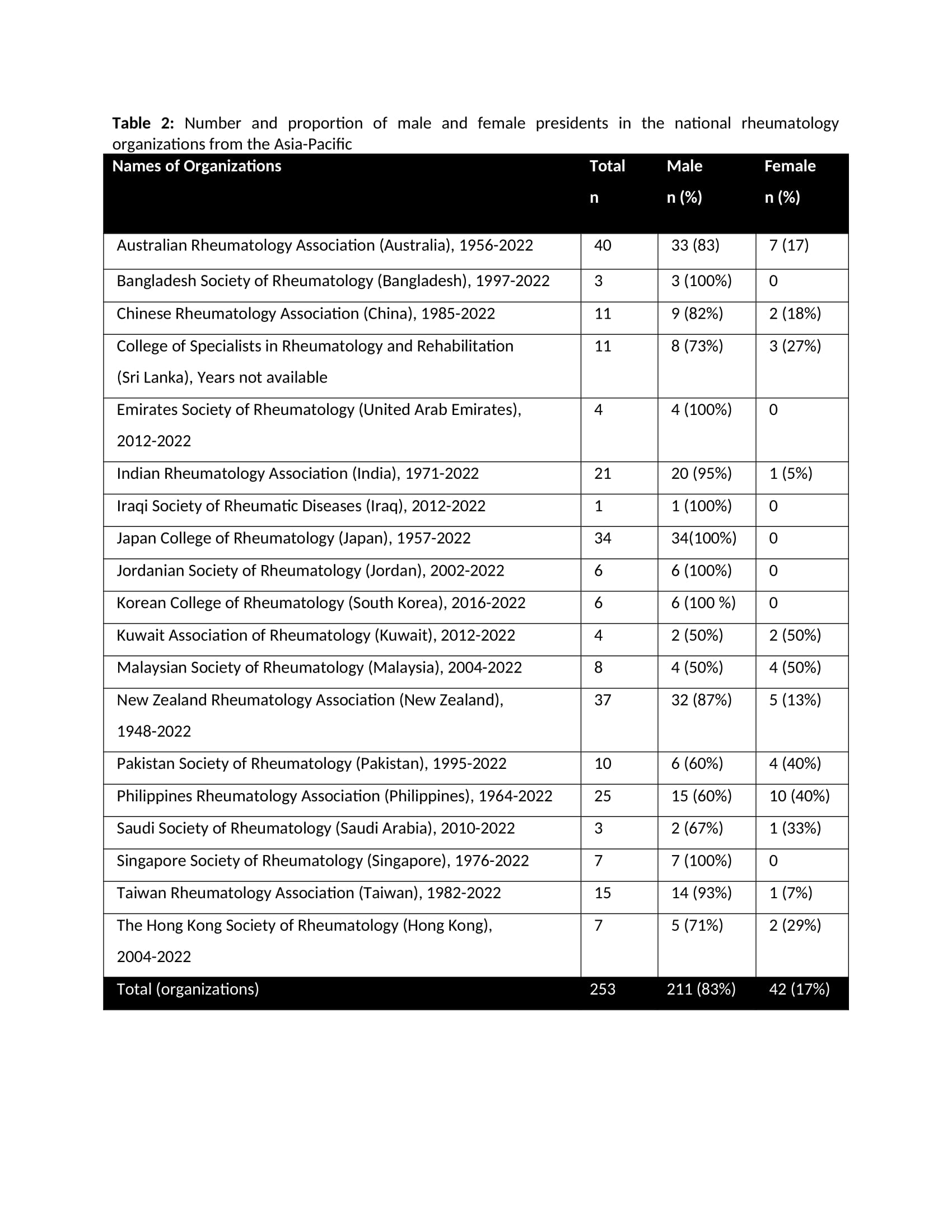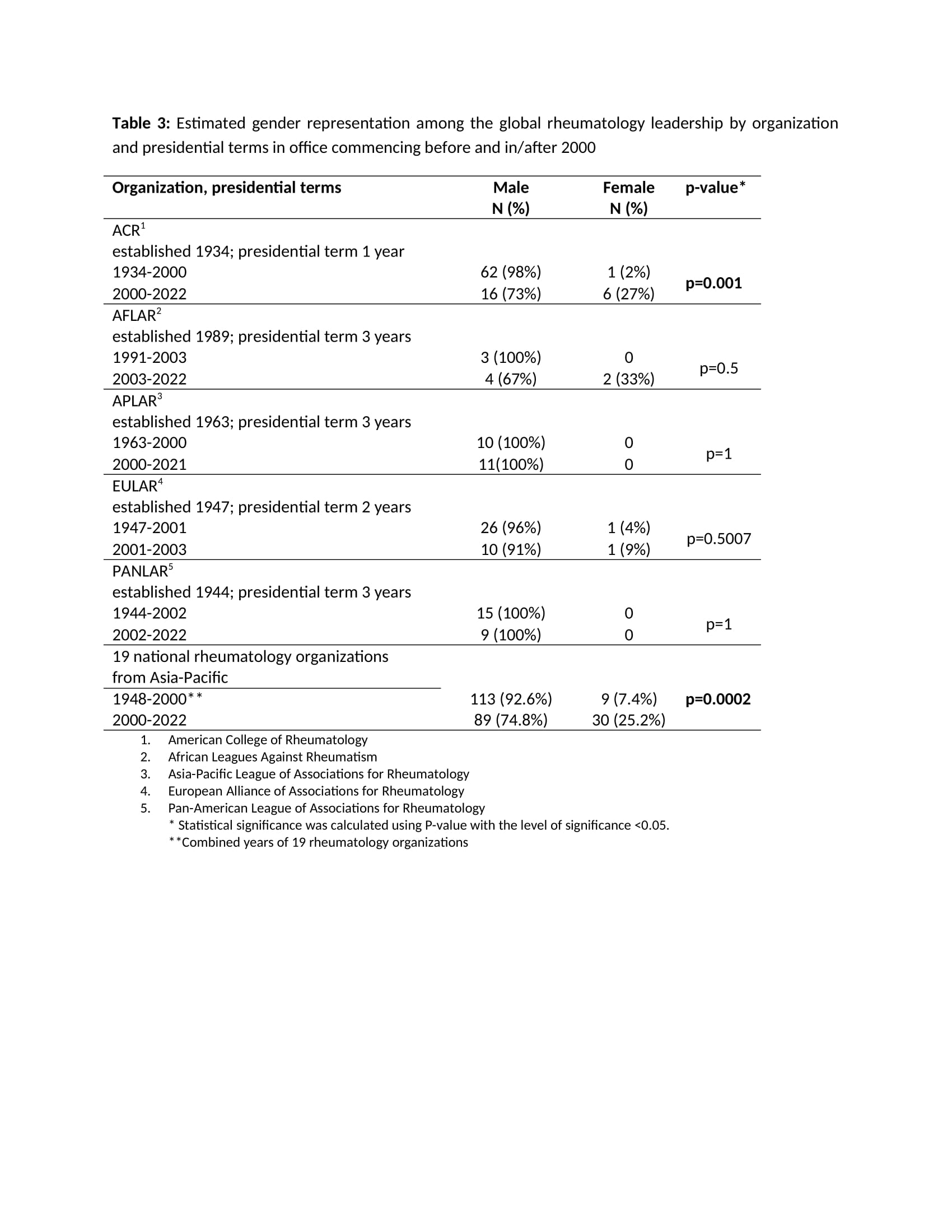Back
Poster Session A
Diversity, inclusion and racial disparities
Session: (0085–0122) Healthcare Disparities in Rheumatology Poster
0085: Closing the Gender Gap in Global Rheumatology Leadership- Are We There Yet?
Saturday, November 12, 2022
1:00 PM – 3:00 PM Eastern Time
Location: Virtual Poster Hall
- TK
Tayyeba Khursheed, MBBS
Pakistan institute of Medical Sciences
Islamabad, Pakistan
Abstract Poster Presenter(s)
Tayyeba Khursheed1, Pavel Ovseiko2, Ghita Harifi3, Humeira Badsha4, Harish G Shekar5 and Latika Gupta6, 1Pakistan Institute of Medical Sciences, Islamabad, Pakistan, 2John Radcliffe Hospital, Oxford, Oxford, United Kingdom, 3Department of Rheumatology, Mediclinic Parkview Hospital, Dubai, United Arab Emirates, 4Dr. Humeira Badsha Medical Center, Dubai, United Arab Emirates, 5Rajarajeswari medical College and hospital, Bangalore, India, 6Royal Wolverhampton Trust, Wolverhampton/University of Manchester, United Kingdom
Background/Purpose: The gender equity in academic rheumatology initiative has sparked discussions on the effect of inequity in academia on assignment to leadership roles. To explore whether a gender gap exists in the global rheumatology leadership, we undertook a cross-sectional review of gender representation among the presidents of regional leagues, and national organizations in Asia-Pacific.
Methods: The names and terms in office of current and past presidents, of 5 regional rheumatology leagues and 19 national rheumatology organizations were obtained from the official website of each organization. The binary gender of each president was estimated using the name-to-gender inference platform Gender-API. Proportions of male and female presidents were determined for each organization and compared for presidencies commencing before and in/after the year 2000. Differences in female representation over time were tested using Fisher's exact test.
Results: The overwhelming majority of all the past and current presidents of regional rheumatology leagues (94%) and national rheumatology organizations were men (83%) (Table 1,2). 2/5 of regional rheumatology leagues and 7/19 of national rheumatology organizations had all-male presidents (Table 1,2). The proportion of female presidents increased in many leagues in/after the year 2000. However, the results were significant only for the American College of Rheumatology (ACR), and the 19 rheumatology organizations from Asia-Pacific when analyzed as a whole. (Table 3).
Conclusion: A gender gap in leadership seems to be prevalent in rheumatology globally, although trends indicate improvement in some regions in the past 2 decades. Regional rheumatology leagues and organizations should step forward to promote gender equity and overcome disparities.
.jpg) Table 1. Number and proportion of male and female presidents in the regional rheumatology leagues.
Table 1. Number and proportion of male and female presidents in the regional rheumatology leagues.
 Table 2: Number and proportion of male and female presidents in the national rheumatology organizations from the Asia-Pacific
Table 2: Number and proportion of male and female presidents in the national rheumatology organizations from the Asia-Pacific
 Table 3: Estimated gender representation among the global rheumatology leadership by the organization and presidential terms in office commencing before and in/after 2000
Table 3: Estimated gender representation among the global rheumatology leadership by the organization and presidential terms in office commencing before and in/after 2000
Disclosures: T. Khursheed, None; P. Ovseiko, None; G. Harifi, None; H. Badsha, None; H. Shekar, None; L. Gupta, None.
Background/Purpose: The gender equity in academic rheumatology initiative has sparked discussions on the effect of inequity in academia on assignment to leadership roles. To explore whether a gender gap exists in the global rheumatology leadership, we undertook a cross-sectional review of gender representation among the presidents of regional leagues, and national organizations in Asia-Pacific.
Methods: The names and terms in office of current and past presidents, of 5 regional rheumatology leagues and 19 national rheumatology organizations were obtained from the official website of each organization. The binary gender of each president was estimated using the name-to-gender inference platform Gender-API. Proportions of male and female presidents were determined for each organization and compared for presidencies commencing before and in/after the year 2000. Differences in female representation over time were tested using Fisher's exact test.
Results: The overwhelming majority of all the past and current presidents of regional rheumatology leagues (94%) and national rheumatology organizations were men (83%) (Table 1,2). 2/5 of regional rheumatology leagues and 7/19 of national rheumatology organizations had all-male presidents (Table 1,2). The proportion of female presidents increased in many leagues in/after the year 2000. However, the results were significant only for the American College of Rheumatology (ACR), and the 19 rheumatology organizations from Asia-Pacific when analyzed as a whole. (Table 3).
Conclusion: A gender gap in leadership seems to be prevalent in rheumatology globally, although trends indicate improvement in some regions in the past 2 decades. Regional rheumatology leagues and organizations should step forward to promote gender equity and overcome disparities.
.jpg) Table 1. Number and proportion of male and female presidents in the regional rheumatology leagues.
Table 1. Number and proportion of male and female presidents in the regional rheumatology leagues. Table 2: Number and proportion of male and female presidents in the national rheumatology organizations from the Asia-Pacific
Table 2: Number and proportion of male and female presidents in the national rheumatology organizations from the Asia-Pacific Table 3: Estimated gender representation among the global rheumatology leadership by the organization and presidential terms in office commencing before and in/after 2000
Table 3: Estimated gender representation among the global rheumatology leadership by the organization and presidential terms in office commencing before and in/after 2000Disclosures: T. Khursheed, None; P. Ovseiko, None; G. Harifi, None; H. Badsha, None; H. Shekar, None; L. Gupta, None.

